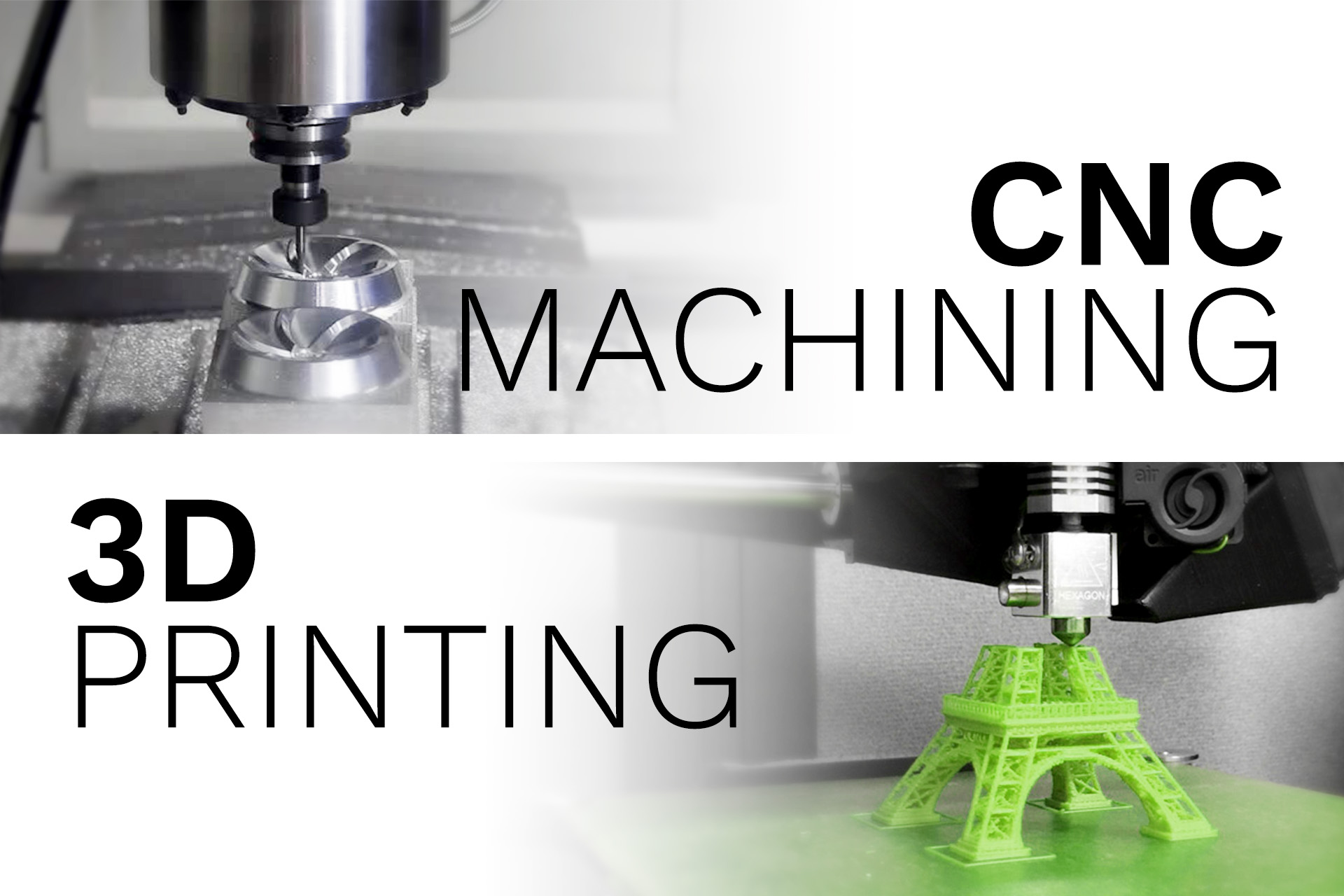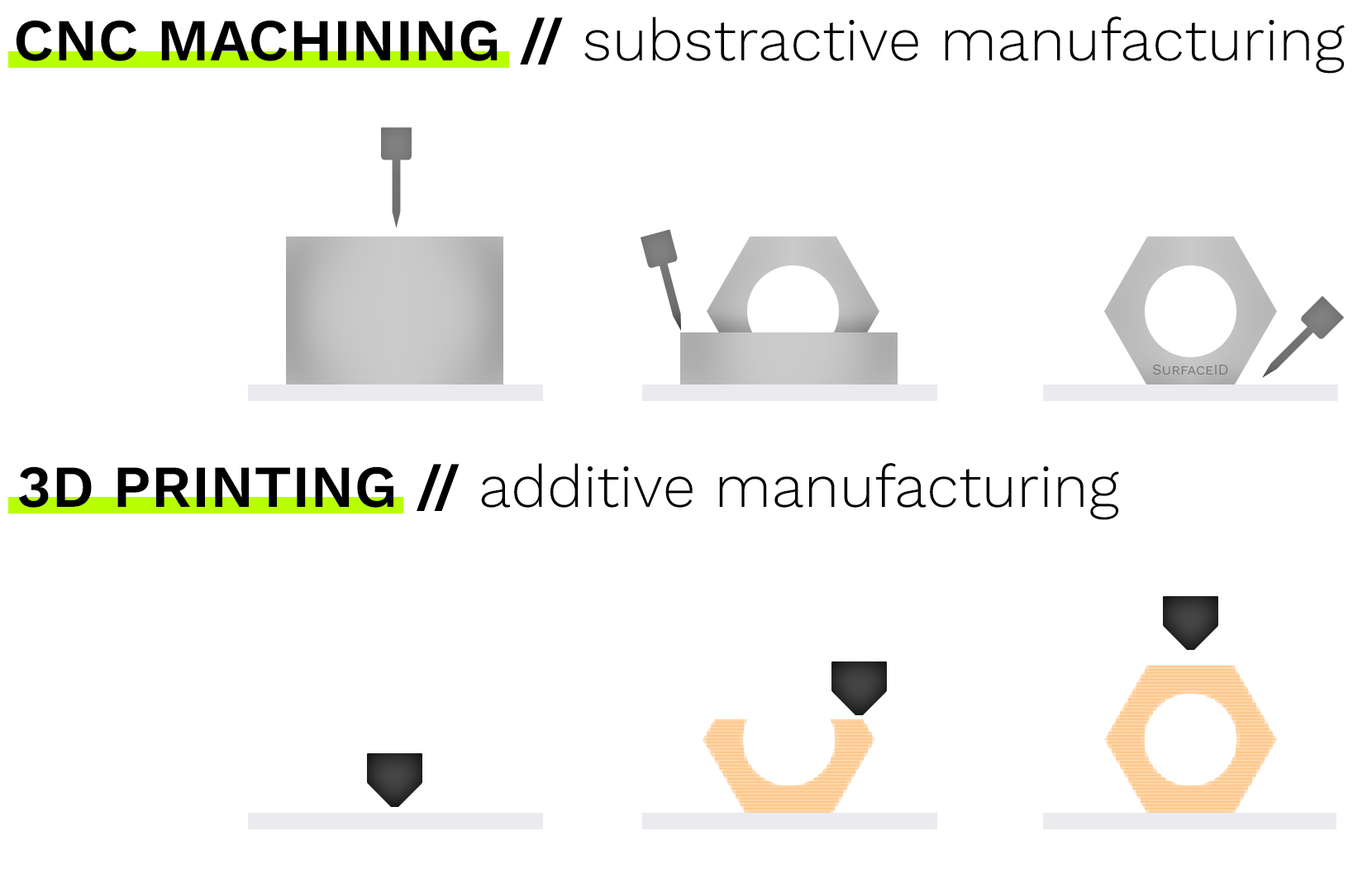As product designers, customers constantly come to us urging us to manufacture products in-house through 3d printing. Everyone is going crazy for 3D-prints these days. And understandably so, it’s like Star Trek magic—to be able to input some data in the replicator, press go, and voilà! Magic shapes will appear!
We at SurfaceID have come to understand that 3d printing is not the magic pill for everything. Sure, there are sometimes some benefits; namely speed. But there are also unexpected drawbacks; namely strength.
But even though strength can be an issue, there are huge benefits to the 3d printing industry. What follows is our discussion and presentation of our 3d printing perspective, and the comparably useful process of CNC.

While the end results can sometimes look similar, CNC machining and 3D printing operate in opposite ways. 3D printing uses a cutter to substract parts from a solid block of any material. While CNC uses a printer to add thin layers of printable material on top of each other.

We want to make the best use of each of those two processes, as we know that CNC machining and 3D printing have very distinct applications and limitations.
Speed and simplicity
3d Printing
One of the biggest advantages of 3D printing is how simple the whole process is when you need to produce a single piece. It builds from scratch in a linear fashion from bottom to top, with no supervision needed. Because of the way the layering works, a 3D printer doesn’t care much about the structural complexity of the 3D model. Although temporary support is sometimes needed, which can result in scarring (cosmetic imperfections) and wasted material. At SurfaceID, we have used the quick nature of 3D printing from prototyping to finalized products. One example is our scientific instrument housings, which are engineered for peak-performance.
Example
For the sake of example, imagine the letter H being printed vertically. The middle part is too large and at an angle too sharp from its two supporting columns, so you can’t do natural bridging. The final product would look like the H is melting in the middle because when the printing occurs, the material is very soft. Instead, the 3D printer can add a temporary support under the bridge. The support material is then cut off once the printing job is done. It is important to try to have the least amount of support material because it will leave a mark when removed.

In contrast, the letter X can be printed upright without any support because the angles give enough tolerance for the structure to hold tight during the whole process. The following print is self-supporting:

In small volumes, 3D printed parts can be delivered within a day and at a very low cost. Be wary of quick and inexpensive 3D prints though. They are usually made from cheaper and more brittle materials and on low resolution printers. The parts will often break easily, and are only good for visual checking.
The nature of 3D printing materials makes the product rough on the edges, and the finalized piece not fit for many conditions. 3D prints won’t resist friction, shocks or heat. 3D printers shine when it comes to decorative hollow parts or meshes. In the last few years, it opened the way to creating very intricate designs using innovative materials. See below some visually enticing prosthetic parts.

CNC
CNC machining takes a lot more time and skill to set up. Depending on the CNC machine and the geometry of your model, it can require a supervisor to rotate the piece (sometimes more than once), switch the head of the drill for detail, or adjust the speed of the motors.
CNC will remove as much material from the blank as it needs to create empty space, so the waste is considerable. The CNC enclosure can get messy and it’s generally not the kind of hardware that you would find outside of a dedicated manufacturing room.
CNC equipment can include a lathe or moving table with up to 5 axes. When streamlined properly for bigger production scale (10-100 pieces), CNC machining is typically much faster than 3D printing.


Strength and precision
CNC can mill almost anything from a blank. Stainless steel, aluminum, wood, foam, ice, etc. CNC precision can also go beyond what the eye can see. If you need two parts of any material to fit together with zero margin for error, this is the way to go. For example, CNC machining can be used to create cylinders and their matching pistons, fit for driving a car on the road.

A hollow sphere is strictly impossible in CNC unless you stick two separate halves together. 3D printing is like sticking a slice of plastic over another, over and over again… This is why the layering is often obvious up-close with the stair effect appearing on the outer surfaces.

Conclusion
In 2018, 3D printing has room for a lot of improvements, and they seem to be coming. Recent 3D printers have started to use ecological materials like corals or recycled plastic trash. Metal 3D printing is also a thing you might have heard about. The most common 3D printers available are low resolution and the pieces produced won’t find a long-term use. Very expensive 3D printers ($80,000 and above) do make precise strong parts that can compete with CNC quality, but not price. If you’re willing to pay a lot of money for very expensive 3D prints, you can get high quality parts.
For SurfaceID’s industrial design and mechanical engineering activities, the quality and durability of CNC machining are still miles ahead of what a reasonably priced 3D print can provide to us and to our customers. But we regularly use 3D printing for rapid visual checking, fit-testing and non-durable repairs,. The choice is always very welcome!